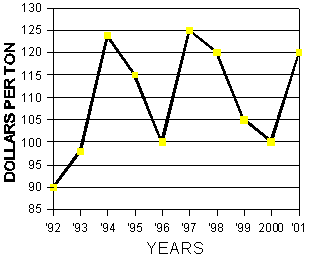Alfalfa Report
Yuma County, Arizona
March 26, 2001
Yuma County Office
2200 W. 28th Street, Ste. 102
Yuma, AZ 85364
(520) 726-3904
(520) 726-8472 FAX
Production Update:
PDF version, 14KB
Hay Preservatives (Part 1): Hay preservatives allow hay to be baled at moisture ranging from 25 to 30% without damage from heat and mold. The advantage of baling at a high moisture content, of course, is to lessen harvesting and storage losses, decrease the chance of rain damage, extend the period during the day when baling is possible, and improve hay quality. Hay preservatives are normally applied with the baler. Preservatives are most economical when they allow rain damage to be avoided.
Insect Management: Threecornered alfalfa hopper, Spissistilus festinus (Say) is a treehopper commonly found in desert alfalfa. Populations build up in spring and persist into the fall. They feed by inserting their needle-like mouth parts into stems, sucking out juices. Adult female hoppers girdle stems by depositing eggs, causing the stem and leaves to turn red, purple or yellow above the girdle. Adults are light-green, thick-bodied, triangular insects about 1/4 inch long that readily fly when disturbed. Nymphs are grayish-white, soft bodied, with saw-toothed spines on their backs. Nymphs are confined to the lower portions of the plant and may not be picked up in a sweep net. There are rarely enough threecornered alfalfa hoppers in alfalfa fields to cause economic damage. Definitive monitoring and treatment guidelines have not been developed because threecornered alfalfa hoppers are a sporadic problem in alfalfa.
Weed Control: Pursuit will not control lambsquarter, sowthistle,
prickly lettuce or grasses but is good on almost all weeds. Tank mixes
or sequential applications of other broadleaf or grass herbicides are
required when these weeds are present.
| Market Summary |
High
|
Low
|
Average
|
Off grade
|
| Past 2 Weeks (Mar. 12 to Mar. 25, 2001) |
125
|
115
|
120
|
90-110
|
| Last Year (Mar. 12 to Mar. 25, 2000) |
105
|
90
|
100
|
70-90
|
10 Year Summary (March 12, to March 25, 1992-2001):

Issued in furtherance of Cooperative Extension work, acts of May 8 and June 30, 1914, in cooperation with the U.S. Department of Agriculture, James A. Christenson, Director Cooperative Extension, College of Agriculture and Life Sciences, The University of Arizona.
The University of Arizona is an equal opportunity, affirmative action institution. The University does not discriminate on the basis of race, color, religion, sex, national origin, age, disability, veteran status, or sexual orientation in its programs and activities.
Any products, services, or organizations that are
mentioned, shown, or indirectly implied in this web document do not imply
endorsement by The University of Arizona.
Information provided by:
Barry Tickes, btickes@ag.arizona.edu Extension Agent, Yuma County
Michael Ottman, mottman@ag.arizona.edu Agronomy Specialist
College of Agriculture, The University of Arizona.
Eric Natwick, etnatwick@ucdavis.edu UCCE Imperial County - Farm Advisor
University of California, Davis, CA.
Material written March 26, 2001.
Forages: Crop Mgmt | Soil Mgmt | Irrigation | Alfalfa Reports | Insects | Diseases | Weeds | Pesticides
Home | Other Crops | Forages
For more Arizona Production Ag Information:
Home | Cotton | Veggies| Forages | Grains | Citrus | Crop x Crop | Insects | Diseases| Weeds | Pesticides | News | Weather | Research | Photos | Contacts | General Info. | Site Map
Copyright © 2001 University of Arizona,
College of Agriculture and Life Sciences
Webmaster: Al Fournier (fournier@ag.arizona.edu)